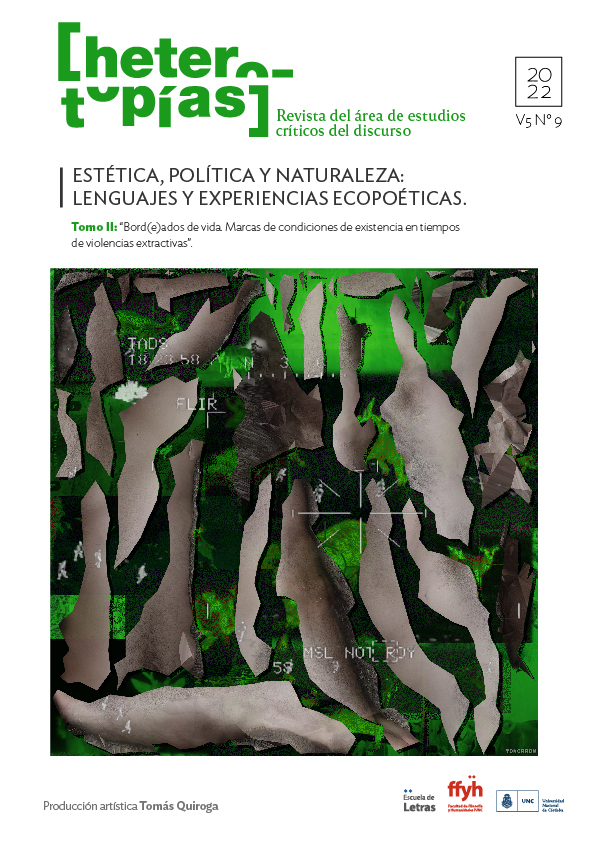The advance of the desert and the imperial way of life Representations of the desertification of the Cuyo region Guanacache
Main Article Content
Abstract
Ulrich Brand and Markus Wissen point out that from the colonization process of the 16th century, a model of productivity is imposed, which defines an “imperial way of life”, within the framework of capitalist hoarding of land and resources. This presentation analyzes different works that’s address the problem of desertification in the region of Guanacache (Cuyo, Argentina), a space that in the 16th and 19th centuries was an andean path between the cities of Mendoza, San Juan and San Luis. The advance of the desert, the drought and the famine on this once natural aquifer system where exiled indigenous communities survived, is the great articulating theme of Mercedes Araujo’s novel, The daughter of the goat (2021). Also, this text analyzes its formal construction and the way in which it is related to the fictions of Antonio Di Benedetto and Juan Draghi Lucero, and with the series “Vestigios Huarpes” of the painter Fidel Roig Matóns.
Downloads
Article Details

This work is licensed under a Creative Commons Attribution-NonCommercial-ShareAlike 4.0 International License.
Those authors who have publications with this journal, accept the following terms: Those authors who have publications with this journal, accept the following terms:
a. The authors will keep their copyright and guarantee to the journal the right of first publication of their work, which will be simultaneously subject to the Creative Commons Attribution - Non-Commercial - Share Alike (by-nc-sa) Attribution License; no commercial use of the original work or any derivative works is allowed, the distribution of which must be done with a license equal to the one that regulates the original work.
b. Authors may adopt other non-exclusive license agreements for the distribution of the published version of the work (e.g., deposit it in an institutional telematic archive or publish it in a monographic volume) provided that the initial publication in this journal is indicated.
c. Authors are allowed and recommended to disseminate their work through the Internet (e.g. in institutional telematic archives or on their website) before and during the submission process, which may lead to interesting exchanges and increase the number of citations of the published work. (See The effect of open access).
References
Araujo, M. (2012). La hija de la cabra. Buenos Aires: Bajo la luna.
Brand, U. y Wissen, M. (2021). Modo de vida imperial. Vida cotidiana y crisis ecológica del capitalismo. Buenos Aires: Tinta limón.
Brand, U. y Dietz, K. (2014). (Neo-)Extraktivismus als Entwicklungsoption? Zu den aktuellen Dynamiken und Widersprüchen rohstoffbasierter Entwicklung in Lateinamerika [¿(Neo)extractivismo como opción de desarrollo? Sobre las dinámicas contradicciones actuales del desarrollo basado en las materias primas en Latinoamérica]. En Politische Vierteljahresschrift, 48, 128-165. Recuperado de doi.org/10.5771/9783845250298_133
Cohen, M. (2008). El mediador. En Zama, 1(1),137-146.
Colombres, A. (2002). Prólogo. En Draghi Lucero, Juan. Las mil y una noches argentinas (pp.7-12). Buenos Aires: Colihue.
Criach, S. (2019). Existencia, nada y absurdo en la narrativa de Antonio Di Benedetto. (Tesis de doctorado). Mendoza: Universidad de Filosofía y Humanidades de la Universidad Nacional de Cuyo. Mimeo.
Di Benedetto, A. (2009). Cuentos completos. Buenos Aires: Adriana Hidalgo.
Draghi Lucero, J. (1978). La cabra de plata. San Antonio de Padua: Ediciones Castañeda.
Frank, A. G. (1970). Capitalismo y subdesarrollo en América Latina. México: Siglo XXI.
Néspolo, J. (2004). Ejercicios de pudor. Sujeto y escritura en la narrativa de Antonio Di Benedetto. Buenos Aires: Adriana Hidalgo.
Néspolo, J. (2014). Tracción a sangre. Ensayos sobre lectura y escritura. Buenos Aires: Katatay.
Néspolo, J. (2018). Narrativas históricas de la posmodernidad argentina. En Historia crítica de la literatura argentina (pp. 265-285). Tomo 12, Buenos Aires: Emecé.
Néspolo, J. (2020). Imperio Kitsch. Ornamento y cultura en el cambio de milenio. Buenos Aires: Katatay.
Rodríguez, A. (1955). Donde haya Dios. Mendoza: D’Accurzio.
Rodríguez, A. (1952). Matar la tierra. Mendoza: Voces.
Varela, F, I. (2016). La historia de los sin historia: resignificaciones del pasado en la obra de Antonio Di Benedetto. Landa, 5 (1), Santa Catarina,180-99. Recuperado de https://repositorio.ufsc.br/xmlui/handle/123456789/177490
Lobos, N. (2004) Para pensar la identidad cultural en el desierto de Lavalle. Confluencia. 1(4),1-19. Recuperado de https://bdigital.uncu.edu.ar/338
Prieto M., y Abraham, E. M. (2019). Guanacache, la travesía de los profundos cambios. En: Guanacache. Fidel Roig Matóns, pintor del desierto (pp. 119-135). Mendoza: EDIUNC.
